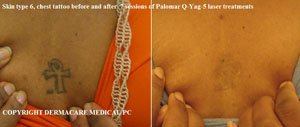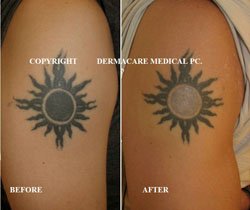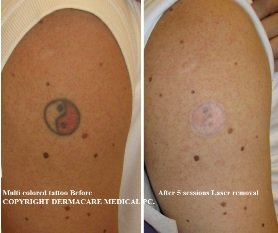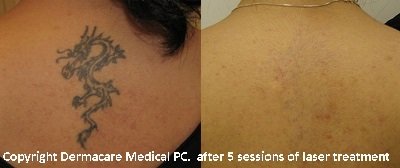First Time To Dermacare Medical? to save on your first treatment Shop Now
Price-Drop! Get up to 50% off on Radiesse Butt Lift No Code Needed
NYC office
36 West 44 Street Suite 1205, New York NY 10036
CALL US (212) 421 8858
Rockland office
165 Washington Street, Tappan NY 10983
CALL US (212) 421 8858
TO BOOK AN APPOINTMENT ONLINE PLEASE
CLICK HERE



 Locations
Locations
October Special:
1 x 1 inch or less -$100 per treatment
any extra inch -$50 per treatment
Initial consult is free
The laser emits a highly focused beam of laser light, which passes harmlessly through the outer layer of the skin and is absorbed primarily by the tattoo ink. *
As the light is absorbed, it is quickly converted to heat. The sudden rise in temperature within the treatment target fractures the ink. Tattoo ink fragments are carried away by the lymphatic system, while pigmented lesions are naturally shed from the skin one to two weeks after treatment.*
Frequently asked questions:
What Kind of Tattoos Can Be Treated?*
A tattoo’s color, depth, and the chemical composition of the ink all affect how it responds to laser light. Black, red, dark orange and dark blue tattoos will usually respond relatively quickly to treatment with laser. However, green, purple, brown, light orange, and light blue colors may respond more slowly. In general, most tattoos can be successfully treated, given a sufficient number of treatments.
How Does It Work?
The laser emits a highly focused beam of intense laser light. This light passes harmlessly through the outer layer of the skin and is absorbed primarily by the tattoo ink or the excess pigment within the lesion. As the light is absorbed, it is converted to heat. This all happens within a tiny fraction of a second, and the sudden rise in temperature within the treatment target fractures the ink. White blood cells then carry away these particles to be naturally eliminated by the body.
Does It Hurt?*
Since the laser light selectively targets the undesired ink, other tissues remain largely unaffected, and therefore most patients report little discomfort. A common way that people describe the sensation of the pulses entering the skin is by comparing them to snaps of a rubber band. If such “snaps” are too uncomfortable, Dr. Yagudin may offer you local anesthesia, but this is usually unnecessary.
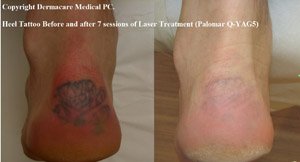 click on image to enlarge
click on image to enlarge
What Happens After Treatment?*
Immediately after laser exposure, the treatment areas may become whitish-colored and swell slightly. This whiteness and swelling tend to go away in about 30 minutes. Over the next several days, some mild crusting may appear over the treatment area. As this crusting resolves, the tattoo will fade. The tattoo will typically continue to fade for many weeks thereafter.
 click on image to enlarge
click on image to enlarge
How Long Does it Take?* the tattoo, each treatment usually takes about 10 to 30 minutes. Some faint tattoos will fade completely after only one treatment, though most require five treatments or more. Treatments should be spaced six to eight weeks apart to give your body sufficient time to fully eliminate loosened particles of ink.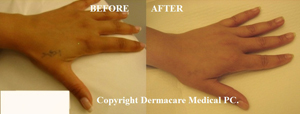 click on image to enlarge**
click on image to enlarge**
Are There Any Side Effects?*
Because the laser beam does not penetrate beyond the skin, side effects are rare. Mild side effects are redness; swelling, blistering, reduction of color of the skin after tattoo is removed (which typically improves over time once treatments are finished). When side effects do occur, they are usually mild and confined to the treatment target. More serious but very rare side effects are infection in the site of the treatment, keloid formation in patients who are prone to abnormal healing. Dr. Yagudin can provide you with complete details of all possible side effects during your initial consultation.
Who are not good candidates for a laser tattoo removal?*
Pregnant and breast feeding women.
Patients who are prone to keloid and hypertrophic scar formation.
Patients with uncontrolled diabetes.
Patients with cosmetic tattoo on their faces.
Patients with active infection, eczema and psoriasis at the site of the tattoo.
Patients with uncontrolled psychiatric disorders.
Patients with unrealistic expectations.
Patients who have ongoing allergic reaction to the ink of their unwanted tattoo.
This list is not complete. Dr. Yagudin has to evaluate every patient individually to establish if there is any other contraindication to your tattoo removal. Please schedule your initial consult to establish the best plan of treatment.
Laser treatment is the only effective method that is unlikely to cause any scarring. The alternatives to laser tattoo removal include surgical excision, salabrasion (using salt to burn away layers of skin), and chemical peels (using acid to burn away layers of skin). These methods not only cause scars but can also be painful. Laser treatment with the Palomar Q-YAG 5 is a state –of-the art treatment that yields excellent results without the perils and disadvantages of other procedures.*
LASER TATTOO REMOVAL POST PROCEDURE INSTRUCTION *
Immediately following treatment, there will be a red discoloration of the skin. A small amount of bleeding, blistering and oozing will occur. This normally heals within 10-14 days. The tattoo will appear foggy and begin its fading process over the next month. Nearly all tattoos require multiple treatments to achieve maximal clearing and are usually scheduled every 6 weeks.
Mild swelling, redness and tenderness are normal for one week.
Apply ice compresses to the treated areas as often as possible for the first 24 hours. Constant cooling of the treated area has shown to be effective in minimizing blistering. Ice compresses may be continued thereafter if you find they offer relief. Be careful not to overuse ice to avoid frost bite.
Remove the dressing after 24 hours and twice daily, wash treated area gently with soap and water, part dry and apply Aquaphor ointment or Vaseline or Petrolatum Jelly To protect the healing tissue, apply the ointment until all areas are completely healed and dry which can take five to fifteen days. Apply a clean non-stick dressing to the area and secure with tape.
Over the next several days blisters may form followed by a scab or thin crust. Any scabs or crusting should be allowed to fall on their own. The underlying skin will remain red for a few days to several weeks. TO MINIMIZE COMPLICATIONS DO NOT PICK OR REMOVE DEAD SKIN OR SCABS!
You may experience some discomfort after the treatment. Treated areas will sting for about one or two hours after treatment. You may take an Acetaminophen (Tylenol) analgesic, as advised, for pain relief. Stronger medications may be prescribed when needed.
Showering/bathing is permitted after 24 hours. Gently pat the area dry; do not rub with a towel or washcloth as this may disrupt the crusting/scabbing process.
Do not apply make-up until all treated areas are dry and healed. This usually takes 7 to 10 days.
Carefully protect your skin from the sun for the first 2 weeks. Wear a sunscreen (SPF 30 or greater) for 6 weeks after treatment.
Avoid swimming, hot tubs and contact sports while crusts are present.
If the treatment area shows signs of infection-profound redness, swelling or tenderness, or pus, notify Dr. Yagudin.
Treatment intervals are typically six weeks apart. This gives the treated area adequate time to heal. Also, this allows the body time to absorb and discard the tattoo ink through the lymphatic system. Treatment at less than six weeks does not appear to be any more efficacious, however it may create a higher risk for scarring since the treated area may not be adequately healed.
For more information on laser tattoo removal please visit www.lasertatttooremoval.me
* Legal disclaimer:
Results and duration of effect may vary, no guaranty of specific results can be given. Degree of side effects may vary, for full disclosure please read consent for the procedure before your treatment. The content on this website is provided for informational purposes only, and is not intended in any way to substitute professional medical advice during an in office consultation and examination by the physician. Any photos from this web site with text “Copyright Dermacare Medical PC” on them are not allowed to be copied and reprinted in any way without written permission from Dermacare Medical PC.
** Individual results may vary.



Never Miss A Promotion
Subscribe to get updates about our new treatments, exclusive deals & giveaways!
Please contact our office with any questions or to schedule your
consultation with Dr. Yagudin.
Call
(212) 421-8858 today! Or to make
an appointment online click
here
![]()






